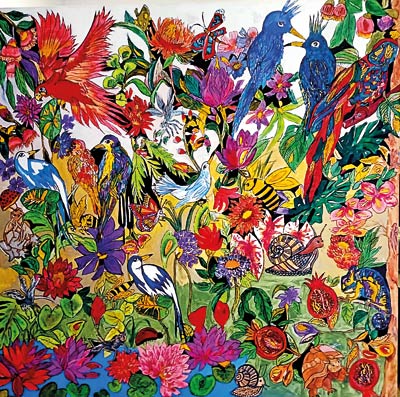Her artistic journey like her canvases is still unfolding
When Melbourne’s Covid lockdowns interrupted the busyness of her entrepreneurial pursuits, Padmini de Silva discovered the joys of long-forgotten free time. It led to self-discovery.
Confined to her home, she began to experiment with whatever lay at hand. She ground fruits and vegetables into natural powders, bottled and labelled them to store in her pantry. She sewed clothes she would have bought. She expanded her culinary skills. And she began to paint with surprising passion, first on calico because it was the only material on hand, and then on canvas.

early work of musicians
What began as a diversion took root and blossomed into an art practice that has since produced over 200 works. In the process, she has forged a distinctive style. Unrestrained by the lack of a formal art education, her works are busy and childlike in their crowding of elements, each piece suggestive of multiple stories, often told in saturated colours, the occasional bold outline, and a disregard for proportion and perspective. A recurrent signature is decorative elements providing harmony and balance.

An entire ecosystem is captured on this canvas
Though she has only been painting seriously for five years, Padmini’s work has already captured the interest of curators. This year, she stood out in two art competitions: Art Connect 2025, the annual exhibition of the Monash Community Art Society (Moncas); and the Frankston Art Exhibition 2025. She received a Public Award in the former and second place in the latter, which is a notable achievement among 282 artists featured. At the time of writing, she was preparing to participate in the Moncas Affordable Art Exhibition at The Track Gallery in Mount Waverley; the Noble Park Community Centre Art Show; and the Monee Valley Art Exhibition. She also intends to display at an art show in Knox. All are Melbourne suburban venues. “Things are certainly progressing for me,” she says, noting that four of her works are listed on Gallery 247, an online registry of Australian artists.
Born in Bambalapitiya to a family from Jaffna, Padmini experienced the loss of her mother early in her life. Her father, a successful entrepreneur, nurtured her curiosity by exposing her to Carnatic music, dance, and art. He also taught her, the only girl in his brood of four, skills traditionally reserved for boys. “I can refit a car engine, drive a truck, and build a house, because I know the principles of engineering,” she says. Proud of her lineage, she signs her works Padmini BKKS, after her maiden family name, Barr Kumarakulasinghe.
This practical independence has kept her busy day and night, with frequent travel managing projects across continents. The hectic pace left no time to revisit an early spark of creativity, when soon after the birth of her daughter, she completed two oil paintings for her family. Even then, she improvised. “I didn’t have canvas, so I painted on Bristol board, and I didn’t have linseed oil, so I used kerosene,” she says.
In the years since emigrating to Australia with her husband Prasanna, Padmini has made Melbourne her home. Stepping into her house in Seaford is like entering a museum of her travels, philosophy and interests. Catholic icons, Buddhist figures, Chinese guardian deities, share space with African masks, Thai sculptures and other artefacts. Amid this eclectic array, her works dominate. The walls are crowded with large and small works, featuring women in cultural and communal settings, as well as colourful odes to nature.

Padmini at work
The female forms are stylised with exaggerated, elongated curves. The signature decorative elements are present in these works. Her nature paintings feature lush, layered tropical foliage, sometimes alive with insects, birds, animated amphibians, and fruits with exposed seeds suggestive of regeneration. Each piece is dense, crowded, and yet perfectly in balance, an ecosystem in paint.
“Feelings and memories are my inspiration,” she explains. “I love music and dance. And I love nature. Both give me happiness. I also admire the aesthetic of the feminine form, so you find a lot of that in my work. I look for subjects that create happiness. The paintings capture that energy. The reward, apart from the joy of creating them, is seeing them light up the face of a viewer.”

Restored pot
Dawn is her favourite time to paint. She looks forward to the break of day to put brush to canvas with the anticipation of “going to a ball – that is how excited I am about painting”. She begins to create without a preconceived form. The painting grows from memories and instinct, a co-creation between herself and her materials. There are gaps between working periods. Work still intrudes into art time.
Also on display at her home are large decorated pots. Salvaged from sidewalks, she has resurrected them with intricately detailed art in vibrant colour. This instinct to restore is central to Padmini’s character. “Everything has a history,” she says, “So, I am loath to throw anything away.” She rejoices in giving the broken a new lease of life. One remarkable pot, painted inside and out with dancers, presents all of Sri Lanka’s varied dance forms.
Turning the discarded into beauty also mirrors her own story of resilience and reinvention because ill-health, too, has shaped her perspective of life. During long stretches of convalescence from a chronic ailment in Melbourne, she would lie in bed watching the trees, birds and changing cloud formations framed in her window. Those are some of the memories now captured on canvas.
While some have urged her to undertake formal art courses, Padmini is hesitant. “My art comes from within,” she says. “It doesn’t need permission. It doesn’t need certificates.” However, at the juncture of publicity, she worries about conventions. Should she formally learn techniques? Nevertheless, feedback she has received from her audiences tells her to forge on.
As her journey continues, one message stands out — Padmini de Silva’s art is more than an aesthetic offering; it is a testament to what becomes possible when one follows the heart, no matter the circumstances. Her story, like her canvases, is still unfolding.
Searching for an ideal partner? Find your soul mate on Hitad.lk, Sri Lanka's favourite marriage proposals page. With Hitad.lk matrimonial advertisements you have access to thousands of ads from potential suitors who are looking for someone just like you.


